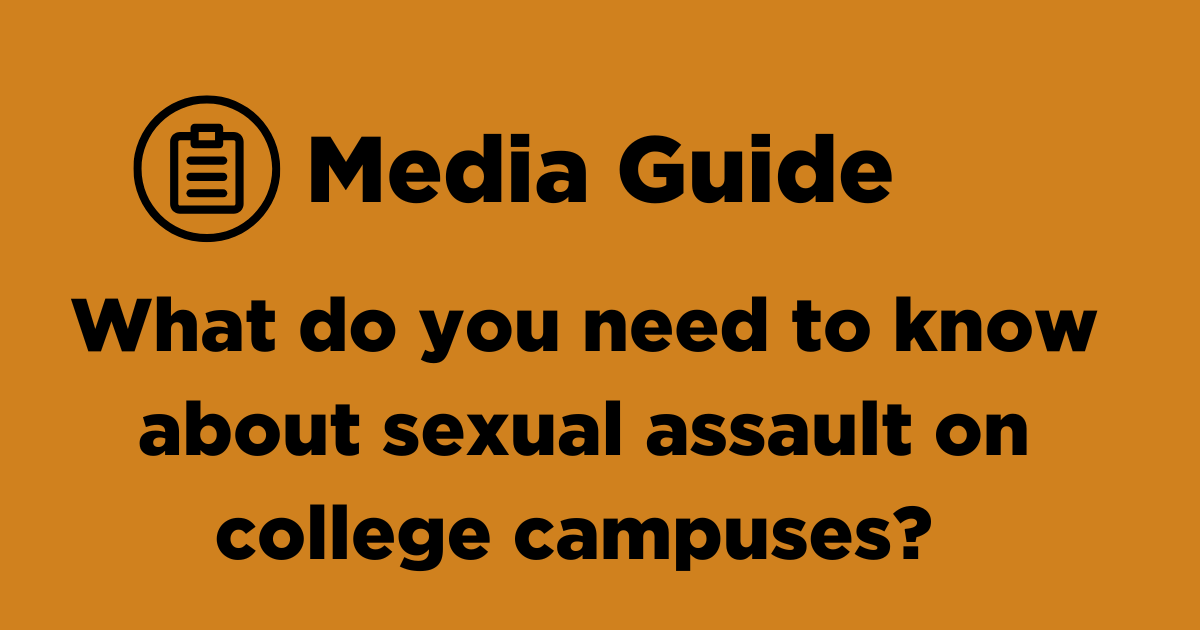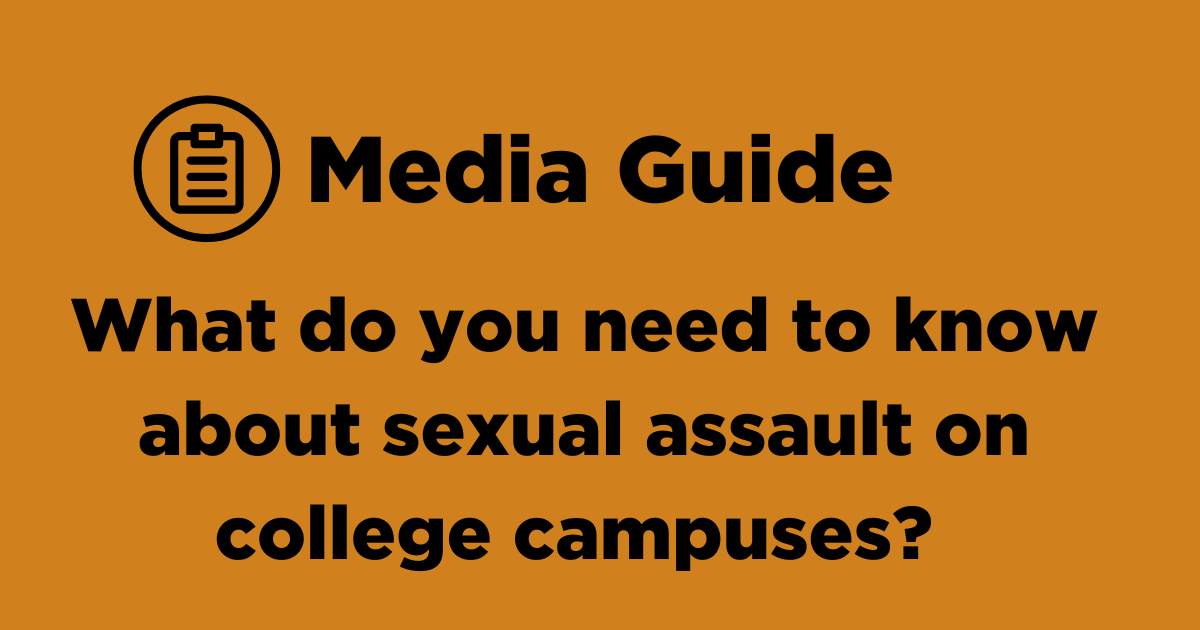
 Sexual violence on college and university campuses is a serious problem in the United States. One[ in five women and one in 16 men are sexually assaulted while in college1). A 2017 analysis, which looked at four studies on the prevalence of college women who have experienced sexual assault, corroborated this commonly cited statistic2).
Sexual violence on college and university campuses is a serious problem in the United States. One[ in five women and one in 16 men are sexually assaulted while in college1). A 2017 analysis, which looked at four studies on the prevalence of college women who have experienced sexual assault, corroborated this commonly cited statistic2).
Less than a third of college women who experienced nonconsensual penetration (rape) sought help from a program or resource, as did 17.8% of men and 42.9% of transgender and nonbinary students3.
Statistics
- Among college women, nine out of 10 victims of sexual assault knew the person who sexually assaulted them (Fisher, Cullen, & Turner, 2000).
- In a nationally representative survey of adults, 34.4% of female rape victims were first raped between ages 18-244.
- People who commit sexual assault often use alcohol strategically. Of the self-reported perpetrators, 75% reported that they had used alcohol before their most recent perpetration incident. Incidents involving alcohol were much more likely to include attempted or completed rape than incidents without alcohol5.
- Over 40% of students experienced at least one sexually harassing behavior in college6.
Prevention
Preventing sexual violence before it occurs requires reducing rates at the population level rather than solely focusing on the health or safety of the individual. CDC recommends a comprehensive approach to preventing sexual assault on campus that includes activities and strategies at the individual level, the relationship level, the community level, and the societal level. Consistent messages must be reinforced across campus policies and programs7.
A comprehensive approach to prevent sexual assault on campus should address multiple goals:
- Changing societal attitudes across the continuum of sexual abuse, assault, and harassment
- Utilizing programs, policies, and prevention approaches to stop perpetration and hold people who perpetrate accountable
- Empowering potential victims with knowledge and skills to defend their sexual rights
- Empowering bystanders to disrupt harmful behavior, intervene on behalf of others and support survivors8.
Consent
Consent should be taught and applied at all levels. However, for some students, it is only once they reach college age that consent becomes part of their conversations and curricula. Since consent is often a topic that comes up when journalists report on sexual assault on college campuses, knowing the definition of sexual consent can help readers understand it.
Consent is an affirmative agreement to do something, either sexual or nonsexual. Consent is an enthusiastic, clearly communicated, and ongoing “yes.” You can’t rely on past sexual interactions and should never assume consent. The absence of “no” is not a “yes.” When sex is consensual, it means everyone involved has agreed to what they are doing and has given their permission. Nonconsensual sex is rape.
Learn more about consent at nsvrc.org/saam/2019 and nsvrc.org/saam/2020
A person who is impaired by drugs or alcohol cannot give consent. People who commit sexual assault often use alcohol and drugs strategically to exploit a victim’s vulnerability, lower their own inhibitions about doing something they know is wrong, and ensure others excuse their actions, as they count on the rest of us to not take it seriously.
Title IX
According to the U.S. Department of Education, Title IX of the Education Amendments of 1972 prohibits discrimination based on sex in education programs and activities that receive federal financial assistance. This means that no one can be excluded from participating or subjected to discrimination in a program or activity that received federal funding based on their sex, sexual orientation, or gender identity). For Title IX, sexual violence falls under the definition of sexual harassment as a form of gender-based discrimination. Other types of discrimination also covered under Title IX include pregnancy discrimination, failure to provide equal athletic opportunities, sex-based discrimination in a school’s science, technology, engineering, and math (STEM) course and programs, and discriminatory application dress code policies/or enforcement, and retaliation9. All school districts, colleges, universities, or institutions that receive federal financial assistance are covered by Title IX. Title IX protects students, employees, applicants, parents and guardians, and all others who interact with a school10.
Under Title IX, school districts, colleges, and universities respond promptly in a manner that is not deliberately indifferent to sexual harassment.The Office for Civil Rights (OCR) is responsible for enforcing Title IX and provides guidance to institutions in complying with the law. Most recently, the Department of Education released a final rule in April 2024 amending the regulations and implementation of Title IX. These final regulations took effect August 1, 202411. If someone is a victim of discrimination, they may file a complaint with OCR under Title IX12.
Clery Act
The Clery Act is a federal law enforced by the U.S. Department of Education that requires colleges and universities to disclose information about crime on campus. As part of the law, schools must publish an annual security report, maintain a public crime log, release crime statistics, issue timely alerts about crime, implement an emergency response plan, and have procedures for handling missing persons cases.
The Campus Sexual Violence Elimination (SaVE) Act, as part of the Violence Against Women Reauthorization Act of 2013, amended the Clery Act, requiring all institutions of higher learning to educate students, faculty, and staff on preventing rape, acquaintance rape, domestic violence, dating violence, sexual assault, and stalking. This legislation raises standards of campus response, disciplinary proceedings, and education about preventing sexual violence13.
1Krebs, C. P., Lindquist, C., Warner, T., Fisher, B., & Martin, S. (2007). The Campus Sexual Assault (CSA) Study: Final report (NCJ 221153). U.S. Department of Justice, National Criminal Justice Reference Service. http://www.ncjrs.gov/pdffiles1/nij/grants/221153.pdf
2Muehlenhard, C. L., Peterson, Z. D., Humphreys, T. P., & Jozkowski, K. N. (2017). Evaluating the one-in-five statistic: Women’s risk of sexual assault while in college. The Journal of Sex Research, 54(4–5), 549–576. https://doi.org/10.1080/00224499.2017.1295014
3Cantor, D., Fisher, B., Chibnall, S., Harps, S., Townsend, R., Thomas, G., Lee, H., Kranz, V., Herbison, R., & Madden, K. (2020). Report on the AAU Climate Survey on Sexual Assault and Sexual Misconduct (Rev. ed.). Association of American Universities.
https://www.aau.edu/sites/default/files/AAU-Files/Key-Issues/Campus-Safety/Revised%20Aggregate%20report%20%20and%20appendices%201-7_(01-16-2020_FINAL).pdf
4“The National Intimate Partner and Sexual Violence Survey.” Centers for Disease Control and Prevention, www.cdc.gov/nisvs/documentation/nisvsReportonSexualViolence.pdf
5Kingree, J. B., & Thompson, M. (2014). A comparison of risk factors for alcohol-involved and alcohol-uninvolved sexual aggression perpetration. Journal of Interpersonal Violence, 30(9), 1478-1492. https://doi.org/10.1177/0886260514540806
6Cantor et al.
7Dills J, Fowler D, Payne G. Sexual Violence on Campus: Strategies for Prevention. Atlanta, GA: National Center for Injury Prevention and Control, Centers for Disease Control and Prevention, 2016.
8Bonar, Erin E. et al. (2022). Prevention of sexual violence among college students: Current challenges and future directions. 70(2). https://stacks.cdc.gov/view/cdc/97297
9“Title IX and Sex Discrimination.” U.S. Department of Education, www.ed.gov/laws-and-policy/civil-rights-laws/title-ix-and-sex-discrimination.
10“Sex Discrimination Faqs.” U.S. Department of Education, www.ed.gov/laws-and-policy/civil-rights-laws/civil-rights-faqs/sex-discrimination.
11“Nondiscrimination on the Basis of Sex in Education Programs or Activities Receiving Federal Financial Assistance.” U.S. Department of Education, 1 Aug. 2024, public-inspection.federalregister.gov/2024-07915.pdf.
12Jeanne Clery Disclosure of Campus Security Policy and Campus Crime Statistics Act of 1990, 20 U.S.C. §1092(f) (2018)
13Ibid.

